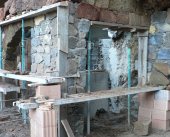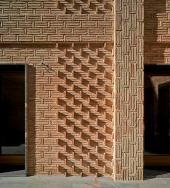




 1
1




regards, Peter








best regards, Byron




Arlyn Gale wrote: One thought - might re-combining the (screened) "dust" from insulated brick cuts be a good addition to refractory mortar mix ... your comments here would also be appreciated.









 1
1








Arlyn Gale wrote:It's about time I report back.








 2
2




regards, Peter




![Filename: Berg2.jpg
Description: [Thumbnail for Berg2.jpg]](/t/42955/a/25361/Berg2.jpg)
 1
1




Peter Peterson wrote:I marked some bricks. They look different from the others. What are they made of? Why did you use them at this place, i.e. what special properties do they have? Are they commercially available? Where?
Peter Peterson wrote:In one of your posts at Permies you say: “... a round ceramic fibre tube one. The bricks are there only to fix this tube in place.” Can you tell me (us) a little more about this tube? Where to buy it? I am in Germany this days.














Peter van den Berg wrote:Funny isn't it? I've made the drawings a couple of years ago and the guys who were filming the workshop found it worthwhile to picture the layer by layer method. Every now and then this video and/or the pictures in it are passing by, leaving me grinning like a Cheshire cat...




Peter van den Berg wrote:
This is made from ceramic fibre, the same stuff as superwool. The tube is made using vacuum with an added binder and is used in industrial processes such as steel melting. It is highly heat resistant, insulating and very little mass, ideal for a heat riser. Try googling "ceramic fibre tube", I've heard of one supplier in Belgium but there should be suppliers all over the world.





regards, Peter




Peter van den Berg wrote:Hi Frere Daran,
The ones I had from Belgium are bought from Joris Pouls, who's building his own version of batch boxes nowadays. He's the one who started to use those superwool risers some years ago. See his website.


|
I found this tiny ad in my shoe
Freaky Cheap Heat - 2 hour movie - HD streaming
https://permies.com/wiki/238453/Freaky-Cheap-Heat-hour-movie
|








